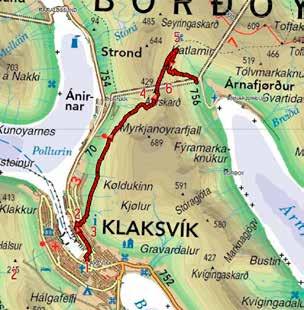
4 minute read
Klaksvík Katlarnir Árnafjørður 1
Klaksvík Katlarnir Árnafjørður
Enjoy the dramatic mountains in the north on this trip through Nólsoyar Páll’s outfield and the old Thing, Katlarnir.
The route starts at the information office in Klaksvík . Walk up through Fjósabrekka and then turn left after Kjalarvegur, approximately five to six hundred metres. Turn right to Helnabrekka and walk 100 metres. Then turn right again along a path that goes diagonally uphill. Here is the gate to the outfield . The route is well marked with reflective wooden poles. This outfield belonged to the Faroese national hero Nólsoyar Páll (1766-1809) (page 58) and has been in the family ever since. Nólsoyar Páll was a shipbuilder, captain, farmer and poet, among other things. In 1804, he built the ship Royndin Fríða together with his brothers. He was frequently in trouble with the Danish authorities in the Faroe Islands who had imposed strict rules for trading, limiting exports and imports to and from the islands. Nólsoyar Páll wrote the satirical ballad, Fuglakvæðið (Bird Ballad), where he made bird caricatures of specific people in the community. The poem prompted anger among the Danish officials in the Faroe Islands, but amusement among ordinary citizens. Nólsoyar Páll disappeared on a voyage in the winter of 1808-1809. Follow the wooden poles uphill just above the first cliff wall. Here, at the seventh wooden pole, you can take a small detour from the route and the wooden poles. Walk about 300 metres to the south until you have a clear view south over Borðoyarvík and north towards Haraldsund. Here, you will find a low wall, about 2x2 metres, built of stone. This is an observation post, which is thought to have been erected by Nólsoyar Páll (probably in early 1807 , i.e. in the midst of the Napoleonic wars), to keep an eye on enemy ships. Here, you see all of Klaksvík, south to Borðoyarnes, the hardy Háfjall, and right ahead, you see Hálgafelli and Klakkur. To the north, you see the island of Kalsoy with the zig-zag shaped mountains and the steep island of Kunoy.
Go back and follow the wooden poles onwards. Walk through the old peat fields where residents in Klaksvík dug and dried peat for fuel. Some places you can see ruins from the ancient sod houses. There are many birds in the area, in particular Curlew, Oystercatcher, Golden Plover, Snipe and Herring Gull.

When you get to the area above Ánir and up to Áarskarð, the landscape becomes more rugged. Be careful because some places may be slippery when wet.
Áarskarð is a real treat. The view over the nice, small village of Árnafjørður and the high mountains that encircle the village is magnificent. To the south you see Lisshøvdi, and north into the bottom of the valley lays the ancient Thing (page 58), Katlarnir, which was the local court for the northern islands in the old days. On both your sides, two high mountains protrude skywards - to the north, Snæfelli, and to the south Myrkjanoyrarfjall.
To reach Katlarnir you must go diagonally down into the valley. There are cairns, but some of them can be difficult to spot. You enter through the area called Niðari Snæhjalli. As you approach the first large stream in the valley, you come to a fence. Climb carefully over the fence and cross the creek. The old Tingsteinur (Thing Stone) is located here . Katlarnir was the local Thing for the northern islands for centuries, where sentences were passed in various disputes and crimes. Parliament was in session during the spring. We do not know when it started, but there are signs that it ended around 1670-80. In addition to the great Thing Stones, there are smaller stones scattered on the rocky plateau, which were probably used for issues related to the Thing. Duration: Three and a half hours to Árnafjørður and four and a half hours back to Klaksvík (return)
Distance: About eight km to Árnafjørður and 11 -12 km back to Klaksvík
Difficulty: Moderate to difficult. Flat terrain above Klaksvík and by Katlarnir but reasonably steep by Áarskarð and in some places down to Árnafjørð
Maximum height: 440 m
Children: The route is not suitable for small children under seven to eight years
Surface: Path marked with wooden stakes on the first part of the route. Then cairn path, where the path can be a little difficult to see in some places. In the area around Áarskarð are many rocks and stones
Maps: 611 and 612
You can now choose to continue down to Árnafjørður or return to Klaksvík the same way you came.
If you choose Árnafjørður, you must walk about 500 metres back towards Áarskarð. However, do not climb Áarskarð again, but maintain roughly the same altitude as Katlarnir until you come to Rossastígar . There is a passage between the rocks where you can head down. Head for the scout hut that is further down where you will find the path down to the road between the two tunnels.
Follow the cairns, but be very careful as the terrain is steep in some places. You come down onto the road between the two tunnels. The distance from here to the village of Árnafjørður is approximately one kilometre. The village is one of the oldest in the northern islands and the inhabitants mostly work in salmon farming. There are also good areas for lobster fishing in the fjord.










